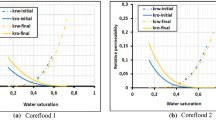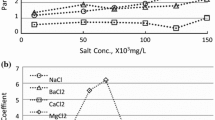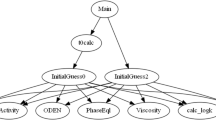Abstract
Low-salinity waterflooding (LSWF) process has gained much attention in recent years as a promising enhanced oil recovery (EOR) method because of its potential for a superior performance, especially through extensive laboratory studies. This study reviews a rigorous and systematic laboratory-to-field approach involving research, discovery and validation using experimental and simulation components. The impact of various ionic compositions on LSWF is evaluated including a fundamental understanding of water geochemistry and the likely geochemical reactions that would occur during the process. Roles of crude oil/brine/rock (COBR) interactions and resulting rock surface charges are investigated as well. In so doing, authors present findings of their studies to support their analysis. Both experimental and simulation components are treated as complementary to each other. Experimental components included reservoir-condition high-pressure high-temperature (HPHT) displacement tests in composite cores using brines of different salinities and specially designed ionic compositions; investigation of wettability alteration—presumably a key LSWF mechanism—in a unique and specifically designed HPHT imbibition cell; Zeta potentiometric studies using a Zeta potentiometer capable of more representative evaluation in brine-saturated whole cores rather than with pulverized samples. Simulation studies involved validation of likely geochemical reactions during LSWF; incorporating oil/brine/rock interactions, and then, linking laboratory data to data from a candidate reservoir to complement the process. Findings of the coreflooding experiments proved conclusively that LSWF with certain specific ionic composition yielded a higher oil recovery. HPHT imbibition tests yielded both visual and quantitative estimations and visual real-time monitoring of how the wettability alteration took place during LSWF and how it was impacted by the degree and magnitude of both temperature and pressure as the vivid variations in the contact angles were clearly captured. Using a whole reservoir core rather than pulverized samples, Zeta potentiometric studies enabled an investigation of the charging behavior at the rock-water interface at various salinities. A new method to estimate Zeta potential in high-salinity environment was developed and validated, and it conclusively proved that rock surface charge played a vital in the LSWF process. The simulation studies included incorporation of experimental data generated during the study, identification of a set of likely geochemical reactions during the process and complementary field data to study the LSWF performance under various conditions and constraints. A conceptual “laboratory-to-field” approach that can contribute to designing a more efficient LSWF process with optimized ionic chemistry has been proposed based on results and analysis from this study and characteristics of similar types of reservoir targeted.




















Similar content being viewed by others
References
Yildiz, H.O.; Morrow, N.R.: Effect of brine composition on recovery waterflooding of moutray crude oil by waterflood. J. Petrol. Sci. Eng. 14, 159–168 (1996). https://doi.org/10.1016/0920-4105(95)00041-0
Tang, G.Q.; Morrow, N.R.: Influence of brine composition and fines migration on crude oil/brine/rock interactions and oil recovery. J. Petrol. Sci. Eng. 24(2), 99–111 (1999). https://doi.org/10.1016/S0920-4105(99)00034-0
Tang, G.Q.; Morrow, N.R.: Salinity, temperature, oil composition, and oil recovery by waterflooding. SPE Reser. Eng. 12(4), 269–276 (1997). https://doi.org/10.2118/36680-PA
Webb, K.J.; Black, C.J.J .; Tjetland, G.: A Laboratory Study Investigating Methods for Improving Oil Recovery in Carbonates. In: International Petroleum Technology Conference. (2005). https://doi.org/10.2523/IPTC-10506-MS
McGuire, P. L.; Chatham, J. R .; Paskvan, F. K.; Sommer, D. M.; Carini, F. H.: Low salinity oil recovery: an exciting new EOR opportunity for Alaska’s north slope. In: Presented at the 2005 SPE Western Regional Meeting Held in Irvine, CA, USA, SPE 93903. (2005). https://doi.org/10.2118/93903-MS
Zhang, P.; Austad, T.: Wettability and oil recovery from carbonates: effects of temperature and potential determining ions. Colloids Surf. A 279(179–187), 2006 (2006). https://doi.org/10.1016/j.colsurfa.2006.01.009
Lager, A.; Webb, K.J.; Black, C.J.J.; Singleton, M.; Sorbie, K.S.: Low salinity oil recovery—An experimental investigation. Petrophysics 49, 28–35 (2008)
Lager, A.; Webb, K.J.; Collins, I.R.; Richmond, D.M.: LoSal enhanced oil recovery: evidence of enhanced oil recovery at the reservoir scale. In: paper SPE 113976, Tulsa, OK. (2008). https://doi.org/10.2118/113976-MS
Lager, A.; Webb, K.J.; Black, C.J.: Impact of brine chemistry on oil recovery. In: Paper A24 presented at the 14th European Symposium on IOR, Cairo. (2007). https://doi.org/10.3997/2214-4609-pdb.24.A24
Winoto, W.; Loadardjo, N.; Xie, X.; Yin, P.; Morrow, N.: Secondary and tertiary recovery of crude oil from outcrop and reservoir rocks by low salinity waterflooding. In: SPE 154209, 18th SPE IOR Symp., Tulsa, OK. (2012). https://doi.org/10.2118/154209-MS
Romanuka, J.; Hofman, J.P.; Ligthelm, D.J.; Suijkerbuijk, B.M.J.M.; Marcelis, A.H.M.; Oedai, S.; Brussee, N. J.: Low Salinity EOR in Carbonates. In: 18th SPE IOR Symposium, Tulsa, OK, SPE 153869. (2012). https://doi.org/10.2118/153869-MS
Robanna, E.; Buikem, T.A.; Mair, C.; Williams, D.; Mercer, D.J.; Webb, K.J.; Hewson, A.: Low salinity enhanced oil recovery – laboratory to day one field implementation – LoSal EOR into the clair ridge project. In: SPE 161750, Abu Dhabi International Petroleum Exh. & Conference, Abu Dhabi, (2012). https://doi.org/10.2118/161750-MS
Austad, T.; Strand, S.; Høgnesen, E. J.; Zhang, P. Seawater as IOR Fluid in Fractured Chalk. In: Presented at the SPE International Symposium on Oilfield Chemistry, SPE 93000. (2005). https://doi.org/10.2118/93000-MS
Fjelde, I.: Low salinity water flooding experimental experience and challenges, force RP workshop: low salinity water flooding, the importance of salt content in injection water, p. 2008. Stavanger, Norway (2008)
Strand, S.; Austad, T.: Effect of temperature on enhanced oil recovery from mixed-wet chalk cores by spontaneous imbibition and forced displacement using seawater. Energy Fuels 22(5), 3222–3225 (2008). https://doi.org/10.1021/ef800244v
Strand, S.; Austad, T.; Puntervold, T.; Høgnesen, E.J.; Olsen, M.; Barstad, S.M.F.: “Smart Water” for oil recovery from fractured limestone: a preliminary study. Energy Fuels 22, 3126–3133 (2008). https://doi.org/10.1021/ef800062n
Ligthelm, D.J.; Gronsveld, J.; Hofman, J.P.; Brussee, N.J.; Marcelis, F.; Van der Linde, H.A.: Novel waterflooding strategy by manipulation of injection brine composition. In: SPE 119835, EUROPEC/EAGE Conference and Exhibition, The Netherlands. (2009). https://doi.org/10.2118/119835-MS
Alotaibi, M.B.; Cha, D.; Also, A.M.; Yousef, A.A.: Dynamic interactions of inorganic species at carbonate/brine interfaces: an electrokinetic study. Colloids Surf. A 550, 222–235 (2018). https://doi.org/10.1016/j.colsurfa.2018.04.042
Yousef, A.A.; Al-Saleh, S.; Al-Jawfi, M.: The impact of the injection water chemistry on oil recovery from carbonate reservoirs. In: Paper SPE 154077, SPE EOR Conference Oil and Gas West Asia, Oman. (2012). https://doi.org/10.2118/154077-MS
Yousef, A.A.; Al-Saleh, S.; Al-Jawfi, M.: Laboratory Investigation of Novel Oil Recovery Method for Carbonate Reservoirs. CSUG/SPE 137634. (2010). https://doi.org/10.2118/137634-MS
Fathi, S.J.; Austad, T.; Strand, S.: Smart water as a wettability modifier in chalk: the effect of salinity and ionic composition. Energy Fuels 24(4), 2514–2519 (2010). https://doi.org/10.1021/ef901304m
Doust, A.R.; Puntervold, T.P.; Strand, S.; Austad, T.A.: Smart water as wettability modifier in carbonate and sandstone. In: 15th European Symposium on Improved Oil Recovery, Paris, France. (2009). https://doi.org/10.3997/2214-4609.201404857
Puntervold, T.; Strand, S.; Austad, T.: Coinjection of seawater and produced water to improve oil recovery from fractured north sea chalk oil reservoirs. Energy Fuels 23, 2527–2536 (2009). https://doi.org/10.1021/ef801023u
Gupta, R.; Smith, P. G.; Hu, L.; Willingham, T. W.; Lo Cascio, M.; Shyeh, J. J.; Harris, C. R.: Enhanced waterflood for middle east carbonate cores—impact of injection water composition. In: SPE Middle East Oil and Gas Show and Conference, Manama, Bahrain, SPE 142668. (2011). https://doi.org/10.2118/142668-MS
Zhang, Y.; Sarma, H.: Improving waterflood recovery efficiency in carbonate reservoirs through salinity variations and ionic exchanges: a promising low-cost "smart-waterflood" approach. In: Abu Dhabi International Pet. Exh. & Conf., Abu Dhabi, UAE, SPE 161631. (2012). https://doi.org/10.2118/161631-MS
Awolayo, A.N.; Sarma, H.K.; Nghiem, L.X.: Modeling the characteristic thermodynamic interplay between potential determining ions during brine-dependent recovery process in carbonate rocks. Fuel 224, 701–717 (2018). https://doi.org/10.1016/j.fuel.2018.03.070
Awolayo, A.N.; Sarma, H.K.; AlSumaiti, A.S.: An experimental investigation into the impact of sulphate ions in smart water to improve oil recovery in carbonate reservoirs. Trans. Porous Med. 111(3), 649–668 (2015). https://doi.org/10.1007/s11242-015-0616-4
Awolayo, A. N.; Sarma, H. K.; Nghiem, L. X.: A comprehensive geochemical-based approach at modeling and interpreting brine dilution in carbonate reservoirs. In: Paper SPE-182626, SPE Reservoir Simulation Conference, Montgomery, TX, USA. (2017). https://doi.org/10.2118/182626-MS
Gopani, P.H.; Singh, N.; Sarma, H.K.; Mattey, P.; Srivastava, V.R.: Role of monovalent and divalent ions in low-salinity water flood in carbonate reservoirs: an integrated analysis through zeta potentiometric and simulation studies. Energies 14, 729 (2021). https://doi.org/10.3390/en14030729
Belhaj, A. F.; Singh, N.; Sarma, H.K.: Understanding the interactions at rock-water and oil-water interfaces during controlled-salinity water flooding. In: Offshore Technology Conference Asia, Kuala Lumpur, Malaysia. (2022). OTC-31656-MS. https://doi.org/10.4043/31656-MS
Awolayo, A.N.; Sarma, H.K.; Nghiem, L.X.: Brine-dependent recovery processes in carbonate and sandstone petroleum reservoirs: review of laboratory-field studies. Interfac. Mech. Model. Attempts. Energ. 11, 3020 (2018). https://doi.org/10.3390/en11113020
Zhang, P.; Tweheyo, M.T.; Austad, T.: Wettability alteration and improved oil recovery by spontaneous imbibition of seawater into chalk: impact of the potential determining ions Ca2+, Mg2+, and SO42-. Colloids Surf. A Physicochem. Eng. Aspects 301(1–3), 199–208 (2007). https://doi.org/10.1016/j.colsurfa.2006.12.058
Awolayo, A. N.; Sarma, H. K.; AlSumaiti, A. M.: Impact of ionic exchanges between active and non-active ions on displacement efficiency in smart waterflood Application. In: 76th EAGE Conference and Exhibition. (2014). https://doi.org/10.3997/2214-4609.20141011
Tweheyo, M. T.; Zhang, P.; Austad, T.: The effects of temperature and potential determining ions present in seawater on oil recovery from fractured carbonates. In: SPE/DOE Symp. on IOR, Tulsa, OK. (2006). https://doi.org/10.2523/99438-ms
Laben, A.; Al- Kayiem, H.; Alameen, M.; Khan, J.: Experimental study on the performance of emulsions produced during ASP flooding. J. Petrol. Explorat. Product. Technol. (2021). https://doi.org/10.1007/s13202-021-01409-6
Zhu, D.; Li, B.; Li, H.; Li, B.; Cao, Y.; Li, Z.: Effects of low-salinity water on the interface characteristics and imbibition process. J. Petrol. Sci. Eng. (2022). https://doi.org/10.1016/j.petrol.2021.109564
Singh, N.; Sarma, H. K.: Successful in the lab, not as effective in the field? Uncertainties in the field observations of low salinity water flooding in sandstone and carbonate reservoirs-a critical analysis. In: SPE Western Regional Meeting Held Virtually. (2021). SPE-200803-MS. https://doi.org/10.2118/200803-ms
Belhaj, A.; Singh, N.; Sarma, H.: Critical assessment of the hybrid impact of surfactants on modified salinity water flooding. In: SPE Canadian Energy Technology Conference, Calgary, Alberta, Canada. (2022). SPE-208974-MS. https://doi.org/10.2118/208974-MS
Abdelfatah, E.R.; Kang, K.; Pournik, M.; Shiau, B.; Harwell, J.; Haroun, M.R.; Rahman, M.M.: Study of Nanoparticle Adsorption and Release in Porous Media based on the DLVO Theory. In: SPE-185484-MS, SPE Latim America &and Caribbean Petroleum Engineering Conference, Buenos Aires, (2017). https://doi.org/10.2118/185484-MS
Gopani, P.H.; Singh, N.; Sarma, H.K.; Negi, D.S.; Mattey, P.S.: A zeta potentiometric study on effects of ionic composition and rock-saturation on surface-charge interactions in low-salinity water flooding for carbonate formation. In: SPE Western Regional Meeting. (2021). SPE-200804-MS. https://doi.org/10.2118/200804-ms
Fakir, S.H.; Belhaj, A.F.; Singh, N.; Sarma, HK.: Beneficial advantages of nanoparticle-enhanced surfactant-assisted low salinity waterflooding process. In: SPE-213020-MS at the SPE Western Regional Meeting, Anchorage, Alaska, USA. (2023). https://doi.org/10.2118/213020-MS
Singh, N.; Gopani, P.H.; Sarma, H.K.; Mattey, P. S.; Negi, D.S.: Characterization of rock and fluid properties for low-salinity water flooding of highly paraffinic oil in a deep low-permeability high-pressure high-temperature offshore carbonate reservoir. In: OMAE2020–18222 at the ASME 2020 39th International Conference (Virtual) on Ocean, Offshore and Arctic Engineering. (2020). https://doi.org/10.1115/omae2020-18222
Kakati, A.; Jha, N. K.; Kumar, G.; Sangwai, J.S.: Application of low salinity water flooding for light paraffinic crude oil reservoir. In: SPE Symposium: Production Enhancement and Cost Optimisation, Kuala Lumpur, Malaysia. (2017). SPE-189249-MS. https://doi.org/10.2118/189249-MS
Singh, N.; Gopani, P.H.; Sarma, H.K.; Mattey, P.; Negi, D.S.; Srivastava, V.R.; Luxbacher, T.: Charging behaviour at the carbonate rock-water interface in low-salinity waterflooding: Estimation of zeta potential in high-salinity brines. Can. J. Chem. Eng. 1, 1–9 (2021). https://doi.org/10.1002/cjce.24311
Alvarado, V.; Bidhendi, M. M.; Garcia-olvera, G.; Morin, B.; Oakey, J.S.: Interfacial visco-elasticity of crude oil-brine: an alternative EOR mechanism in smart waterflooding. In: SPE IOR Symposium, Tulsa, OK, USA. (2014). SPE-169127-MS. https://doi.org/10.2118/169127-MS
Thomas, S.: Enhanced oil recovery—an overview. Oil Gas Sci. Technol. Rev IFP Energ. Nouvelles 63(1), 9–19 (2008). https://doi.org/10.2516/ogst:2007060
Lashkarbolooki, M.; Ayatollahi, S.: Effect of asphaltene and resin on interfacial tension of acidic crude oil/sulfate aqueous solution: experimental study. Fluid Phase Equilib. 414, 149–155 (2016). https://doi.org/10.1016/j.fluid.2016.01.032
Belhaj, A.F.; Elraies, K.A.; Sarma, H.K.; Shuhili, J.A.; Mahmood, S.M.; Alnarabiji, M.S.: Surfactant partitioning and adsorption in chemical EOR: the neglected phenomenon in porous media. In: SPE/IATMI Asia Pacific Oil & Gas Conference and Exh. (2021). SPE-205676-MS. https://doi.org/10.2118/205676-MS
Dang, T.Q.C.; Nghiem, L.X.; Chen, Z.; and Nguyen, Q.P.: Modeling low salinity waterflooding: ion exchange, geochemistry and wettability alteration. In: Paper SPE 166447 presented at the 2013 SPE Annual Technical Conference and Exhibition, New Orleans, LA, USA. (2013). https://doi.org/10.2118/166447-MS
Kojadinovich, G.: Laboratory investigation of oil-composition affecting the success of low-salinity waterflooding in oil-wet carbonate rocks. (2018). https://etda.libraries.psu.edu/catalog/15770gsk5081
Jackson, M.D.; Al-Mahrouqi, D.; Vinogradov, J.: Zeta potential in oil-water-carbonate systems and its impact on oil recovery during controlled salinity water-flooding. Sci. Rep. 6, 1–13 (2016). https://doi.org/10.1038/srep37363
Belhaj, A.F.; Fakir, S.H.; Singh, N.; Sarma, H.K.: Extensive experimental study of low-salinity waterflooding using hele-shaw cell: a focus on gravity and mobility ratio effects. In: SPE-212785-MSat the SPE Canadian Energy Technology Conference and Exhibition, Calgary, Alberta, Canada. (2023). https://doi.org/10.2118/212785-MS
Belhaj, A.F.; Fakir, S.H.; Singh, N.; Sarma, H.K. A comparative enhanced oil recovery study between low-salinity water and hybrid surfactant process for a carbonate reservoir. In: Presented at the SPE western regional meeting held in anchorage, Alaska, USA. (2023). SPE-212959-MS. https://doi.org/10.2118/212959-MS
Zhang, Y.; Sarma, H.K.: Brine chemistry effects in waterflood and CO2 injection in carbonate reservoirs. In: OMAE2015–23247, Proceedings of the ASME2014 33rd International Conference on Ocean, Offshore and Artic Engineering, San Fransico. (2014). https://doi.org/10.1115/OMAE2014-23247
Mohammadi, S.; Kord, S.; Moghadasi, J.: An experimental investigation into the spontaneous imbibition of surfactant assisted low salinity water in carbonate rocks. Fuel 243, 142–154 (2019). https://doi.org/10.1016/j.fuel.2019.01.074
Feldmann, F.; Strobel, G.J.; Masalmeh, S.K.; Alsumaiti, A.M.: An experimental and numerical study of low salinity effects on the oil recovery of carbonate rocks combining spontaneous imbibition, centrifuge method and coreflooding experiments. Journal of Petroleum Science and Engineering (2020). https://doi.org/10.1016/j.petrol.2020.107045
Okasha, T.M.; Al-Shiwaish, A.J.A.: Effect of brine salinity on interfacial tension in Arab-D carbonate reservoir, Saudi Arabia. In: SPE MEOGS and Conference, Manama. (2009). SPE 119600. https://doi.org/10.2118/119600-MS
Al-Attar, H.H.; Mahmoud, M.Y.; Zekri, A.Y.; Almehaideb, R.; Ghannam, M.: Low-salinity flooding in a selected carbonate reservoir: experimental approach. J. Petrol. Explorat. Prod. 3, 139–149 (2013). https://doi.org/10.1007/s13202-013-0052-3
Farhadi, H.; Ayatollahi, S.; Fatemi, M.: The effect of brine salinity and oil components on dynamic IFT behavior of oil-brine during low salinity water flooding: Diffusion coefficient, EDL establishment time, and IFT reduction rate. Journal of Petrol. Sci. Eng. 196, 107862 (2021). https://doi.org/10.1016/j.petrol.2020.107862
Rostami, P.; Mehrabana, M.F.; Sharifi, M.; Dejam, M.; Ayatollahi, S.: Effect of water salinity on oil/brine interfacial behaviour during low salinity waterflooding: a mechanistic study. Petroleum 5, 367–374 (2019). https://doi.org/10.1016/j.petlm.2019.03.005
Acknowledgements
Authors thankfully acknowledge the funding received for this study from Oil and Natural Gas Corporation Limited, India, under SRA UOC18-19-01 and a Discovery Grant (RGPIN/04841-2019) from the Natural Sciences and Engineering Research Council of Canada. Authors also thank Thomas Luxbacher, Fei Wu and Paras H. Gopani for their contributions to certain laboratory tests and analyses.
Author information
Authors and Affiliations
Corresponding author
Rights and permissions
Springer Nature or its licensor (e.g. a society or other partner) holds exclusive rights to this article under a publishing agreement with the author(s) or other rightsholder(s); author self-archiving of the accepted manuscript version of this article is solely governed by the terms of such publishing agreement and applicable law.
About this article
Cite this article
Sarma, H.K., Singh, N., Belhaj, A.F. et al. A Review and Evaluation of Laboratory-to-Field Approach for Low-Salinity Waterflooding Process for Carbonate Reservoirs. Arab J Sci Eng 48, 15747–15767 (2023). https://doi.org/10.1007/s13369-023-08198-6
Received:
Accepted:
Published:
Issue Date:
DOI: https://doi.org/10.1007/s13369-023-08198-6




